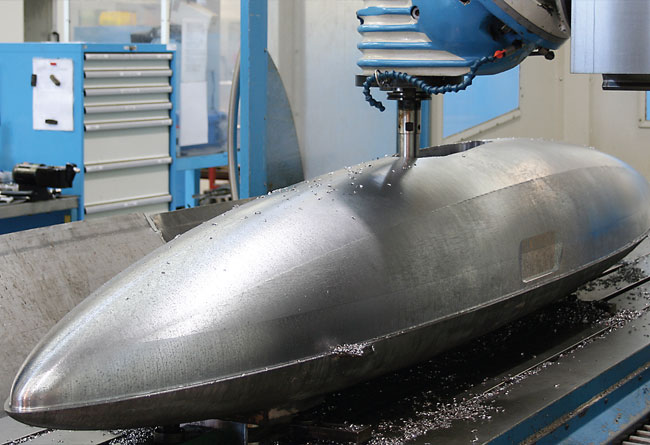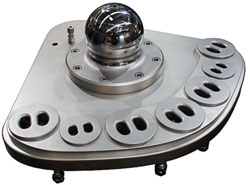

Among the specialists who helped Armel Le Cléac’h to his Vendée Globe victory were some modest engineers working away quietly in Quimperlé…
Guelt, the mother company with its roots in the technically demanding food service industry, founded Guelt Nautic 20 years ago to apply its mature expertise in precision metalwork for applications in another challenging environment: performance sailing. The company’s skill set, which combines hightechnology engineering and design, mechanics, electrics and automation, allows it to take on a wide variety of demanding projects on all scales and in all settings.
With these skills plus a spirit of innovation, Guelt Nautic has become a regular supplier to teams in the world’s top sailing events, the Route du Rhum, Vendée Globe, Volvo, Transat Jacques Vabre and recently the America’s Cup.
Guelt’s 5,700m2 facility in Quimperlé, between the ocean racing centres of Port la Forêt and Lorient, is well established as a prized asset in the delivery of engineering focus and reactivity to many of the most successful skippers and their teams. This gives Guelt a rare opportunity to collaborate closely and frequently with many of the world’s most demanding ocean racing projects.
The Guelt team is proud to have contributed to the victory of Armel Le Cléac’h with Banque Populaire and in great performances by other French skippers in the last Vendée Globe: keel fins and bearings, bulbs, blocks, rudder bearings and other key elements were made and modified in the Guelt workshops; the company’s products could be found on most of the Imoca 60s participating in the latest event.
And straight after the Vendée finish the Guelt technicians were immediately back to work refurbishing Maître Coq’s keel as part of a big refit before the boat went to new owners Initiative Coeur.
An Ultim mast bearing (below): high-grade titanium is used for the main body incorporating the multiple lashing straps to attach the necessary sheaves and fittings. The bearing ball itself is made out of very high-grade stainless steel which has the most suitable wearing properties for a ‘very’ important component – that will remain unseen for many months and often for tens of thousands of miles of high-speed sailing…

In the 35th America’s Cup Guelt Nautic worked with Groupama and skipper Franck Cammas to deliver the key parts for the critical wing control system – to allow precise and friction-free adjustment of the several different wing elements.
Most recently, a Wally superyacht owner placed his faith in Guelt expertise for the manufacture of an all-new fabricated keel to be manufactured in HLES high-strength steel – a nearly three-month project.
Among current projects are some rather large mast bases and fittings for two of the new Ultim trimarans, Gitana 17 and Banque Populaire IX.
The Ultim mast bases are made from a combination of titanium and F16PH stainless steel. The major steel element starts out as a forged block, which is first externally and then internally turned, then milled to its final shape before undergoing a surface treatment to strengthen resistance to wear and to reduce rotation friction. The associated sheave box is made in a similar manner; four to six weeks are required to manufacture a fitting of this size and sophistication.
With the shop’s capacity of 1,200 man-hours per week, working two shifts per day, the fast pace of machining activity places considerable strain on the tooling equipment, aggravated by the extreme hardness of some of the materials used.
The Guelt team’s latest challenge is to integrate ‘additive manufacturing’ for some of the most technical parts, adding more pressure on staff to adapt to new working methods while still producing the highest-quality work. Technicians specify the appropriate materials for each element (eg titanium, high-carbon steel, stainless steel, carbon, PHED plastic, composite etc) to prepare for fabrication using 3D printing. Compared with conventional machining, the additive process has the advantage of using only the precise quantity of material necessary to manufacture a part, keeping it at minimum weight while optimising mechanical and physical qualities. Guelt has already been implementing this process for the production of parts for the two new Ultims – demonstrating impressive confidence in a new technology at a relatively early stage.
Yet Guelt does not only work on large projects: its geographical location, close to the main marinas of Finistère and Morbihan, allows the company to offer a year-round local service, machining a steady stream of smaller fittings for sailors who drop by the workshops.
Guelt Nautic’s strength is not just being able to manufacture good-quality parts, of equal value is the expert advice Guelt makes available to each of its customers followed by a dependable commitment to on-time delivery.
Recently a member of the design team at Groupama Team France visited the factory in Quimperlé to thank the team for the work accomplished on their America’s Cup campaign: ‘I would like to take this opportunity to thank you for all your support…
‘It was a real pleasure to work with you for the first time. We didn’t have any trouble with your parts and I think “the copy” was a good one! Thanks a lot again and see you soon.’
Click here for more information on Guelt Nautic »
We invite you to read on and find out for yourself why Seahorse is the most highly-rated source in the world for anyone who is serious about their racing.
To read on simply SIGN up NOW
Take advantage of our very best subscription offer or order a single copy of this issue of Seahorse.
Online at:
www.seahorse.co.uk/shop and use the code TECH20
Or for iPad simply download the Seahorse App at the iTunes store


